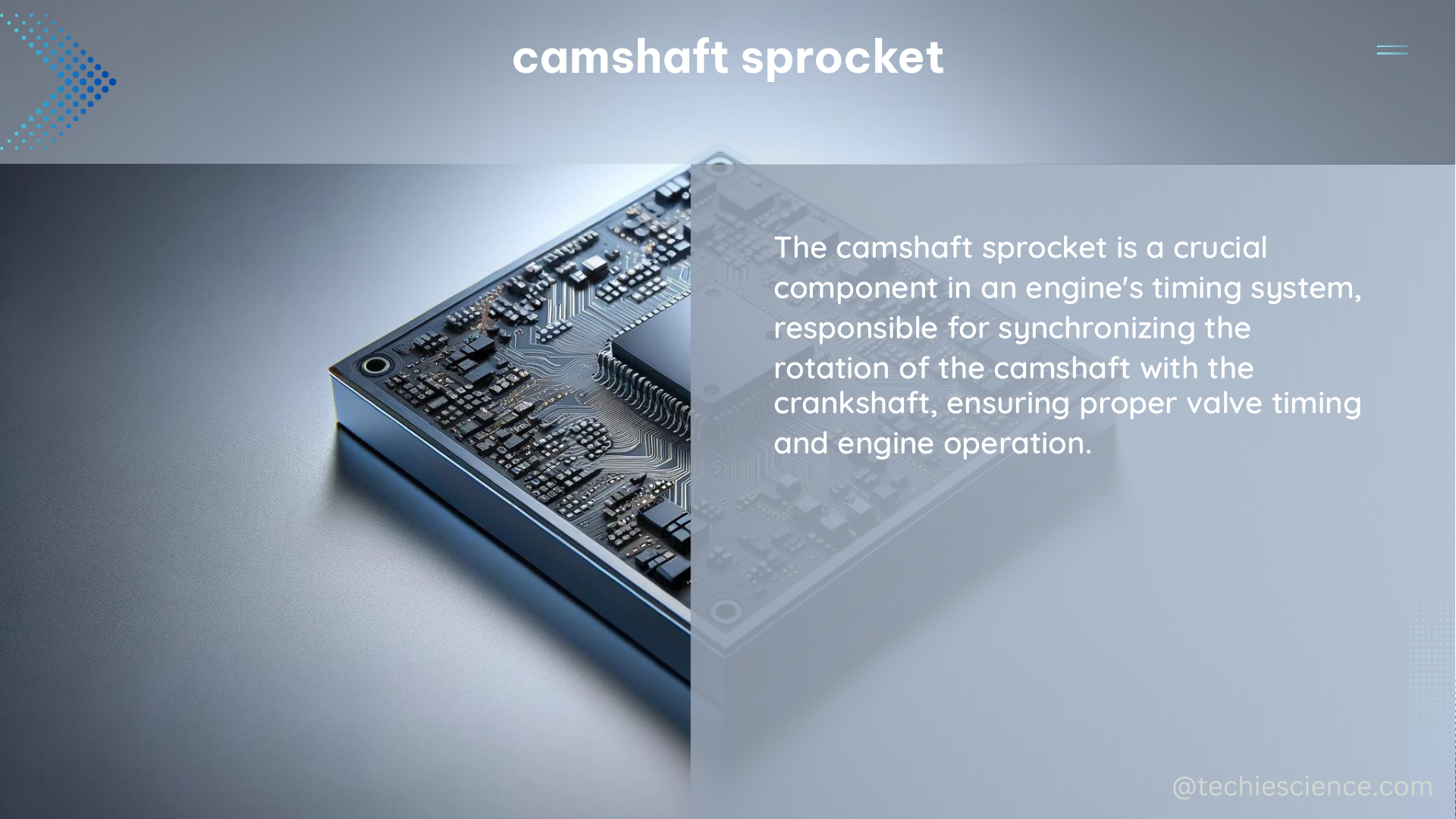Camshaft sprockets are essential components in an internal combustion engine, connecting the camshaft to the crankshaft via a timing chain or belt. The sprocket’s primary function is to maintain the correct phasing between the camshaft and crankshaft, ensuring optimal engine performance and preventing catastrophic damage. This comprehensive guide delves into the technical specifications, materials, and installation process of camshaft sprockets, providing a valuable resource for DIY enthusiasts and automotive professionals alike.
Technical Specifications of Camshaft Sprockets
Material Composition
Camshaft sprockets are typically constructed from high-strength steel or aluminum alloys, ensuring exceptional durability and resistance to wear. The choice of material is crucial, as the sprocket must withstand the significant forces and stresses exerted during engine operation.
- Steel Sprockets: Steel camshaft sprockets are known for their superior strength and longevity. They are commonly used in high-performance and heavy-duty applications, where the engine is subjected to increased loads and demands.
- Aluminum Sprockets: Aluminum alloy sprockets offer a balance of strength and weight reduction, making them a popular choice for many modern engines. The reduced weight can contribute to improved fuel efficiency and responsiveness.
Teeth Count
The number of teeth on a camshaft sprocket varies depending on the engine’s design, typically ranging from 20 to 40 teeth. The teeth count is a critical factor in determining the sprocket’s pitch diameter and the overall timing chain or belt system.
| Engine Type | Typical Teeth Count |
|---|---|
| Small Displacement Engines | 20 to 28 teeth |
| Medium Displacement Engines | 28 to 34 teeth |
| Large Displacement Engines | 34 to 40 teeth |
Pitch Diameter
The pitch diameter is the theoretical diameter of the sprocket where the teeth make contact with the timing chain or belt. It is calculated by multiplying the number of teeth on the sprocket by the pitch of the chain or belt. The pitch diameter is a crucial parameter in ensuring proper timing chain or belt engagement and tension.
For example, a camshaft sprocket with 28 teeth and a chain pitch of 12.7 mm (0.5 inches) would have a pitch diameter of:
* Pitch Diameter = Number of Teeth × Chain Pitch
* Pitch Diameter = 28 × 12.7 mm = 355.6 mm (14 inches)
Pressure Angle
The pressure angle is the angle between the line of action of the timing chain or belt and the normal to the pitch circle of the sprocket. A standard pressure angle for automotive applications is typically 20 degrees, which helps to distribute the load evenly across the teeth and minimize wear.
Face Width
The face width of a camshaft sprocket is the width of the sprocket that comes into contact with the timing chain or belt. The face width is determined by the width of the chain or belt and the design requirements of the engine. A wider face width provides more surface area for the chain or belt to engage, improving load distribution and reducing the risk of premature wear.
Camshaft Sprocket Installation: A DIY Guide

Replacing a camshaft sprocket can be a straightforward task for experienced DIY enthusiasts, but it’s essential to follow the proper procedures to ensure a successful and safe installation. Here’s a step-by-step guide to help you through the process:
Necessary Tools and Safety Gear
- Appropriate wrenches and sockets
- Torque wrench
- Timing mark alignment tools (e.g., timing marks, timing pins)
- Gloves, safety glasses, and hearing protection
Step 1: Identify the Correct Sprocket
Ensure you have the correct camshaft sprocket for your engine by cross-referencing the part number or dimensions with the manufacturer’s specifications. Using the wrong sprocket can lead to improper timing and potential engine damage.
Step 2: Remove the Timing Cover
Before accessing the camshaft sprocket, you’ll need to remove the timing cover, which may require specialized tools and careful disassembly. Consult your engine’s service manual for the specific steps.
Step 3: Mark the Timing
Before removing the timing belt or chain, carefully mark the current timing position to ensure accurate reassembly. This step is crucial for maintaining the correct camshaft and crankshaft synchronization.
Step 4: Remove the Timing Belt or Chain
Carefully remove the timing belt or chain, taking note of any tensioners or guides that may need to be reinstalled. Avoid letting the chain or belt slip out of position, as this can lead to incorrect timing.
Step 5: Install the New Sprocket
Align the new camshaft sprocket with the camshaft and secure it using the appropriate bolts or keys, following the manufacturer’s recommended torque specifications.
Step 6: Reassemble the Timing Components
Reinstall the timing belt or chain, ensuring it is properly aligned and tensioned according to the engine’s service manual. Double-check the timing marks to verify the correct positioning.
Step 7: Reinstall the Timing Cover
Replace the timing cover and any other removed components, torqueing all bolts to the manufacturer’s specifications. Ensure a proper seal to prevent oil leaks and maintain engine protection.
By following these steps and adhering to the necessary safety precautions, you can successfully replace a camshaft sprocket and restore your engine’s optimal performance.
References

The lambdageeks.com Core SME Team is a group of experienced subject matter experts from diverse scientific and technical fields including Physics, Chemistry, Technology,Electronics & Electrical Engineering, Automotive, Mechanical Engineering. Our team collaborates to create high-quality, well-researched articles on a wide range of science and technology topics for the lambdageeks.com website.
All Our Senior SME are having more than 7 Years of experience in the respective fields . They are either Working Industry Professionals or assocaited With different Universities. Refer Our Authors Page to get to know About our Core SMEs.